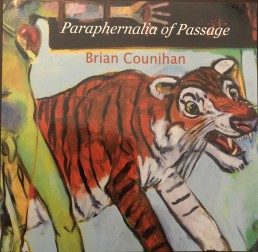Brian Counihan: In His Mind’s Eye Essay
The paintings of Brian Counihan shimmer like a mirage on the horizon. Look at any of his works and experience a myriad of cognitive reactions through the visceral application of paint and by the theatrical performances within. Counihan is a trickster, drawing the viewer into his pictorial plane with remnants of human interaction
and drama.
In his recent exhibition “Paraphernalia for Passage,” Counihan’s bravura sings out in new paintings that perform as a visual dialogue with past generations of artists that influenced him. Counihan is a sampler. By borrowing facets of selected visual culture, he pays demonstrative homage to a diverse group that spans centuries and includes such luminaries as Leonardo Da Vinci, Michelangelo, R.B. Kitaj, Francis Bacon, Marcel Duchamp, and Marc Chagall. His 2009 triptych Oedipus Reborn has distinctive familial ties to Michelangelo’s Creation of Adam, circa 1511. Both compositions are charged with a swirling god tenaciously close to giving the spark of life to the reclining male nude in the center. In Counihan’s work however, the male nude is emasculated. Incapable of bringing human nature into existence, he reclines in an azure embryonic pool encircled by underwater algae. By recontextualizing these appropriations into his larger artistic arsenal, Counihan triumphs in formulating densely layered paraphernalia in his work.
Counihan also intentionally misappropriates from an eclectic variety of sources as displayed in his 2009 painting The Bride Stripped Bare By Her Bachelorettes. Centered in the composition is a female figure garbed in Hanbok, traditional South Korean dress, yet her face is painted as a Japanese geisha. She holds a red fan in one hand and touches her face with the other while peering out coyly at the viewer. She is surrounded by other female figures, which are veiled and in various stages of undress in costumes that span cultures and times. One has a sense of watching a stage performance. In extracting and re-mixing the cultural markers from their original functions, Counihan has succeeded in creating a new context for interpretation.
Counihan’s narratives are distinctly illusionistic through his use of disparate yet related images overlaid onto densely abstract backgrounds, sharing a connected visual relationship to generations of artists before him, and remixing of cultural traditions. The resulting body of work is a substantial feast for the senses.
Amy Moorefield
Director of the Eleanor D. Wilson Museum at Hollins University
May 2010
